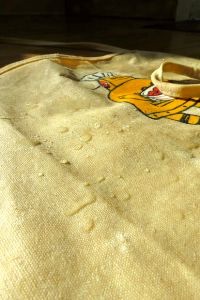I wrote a little about making my fabric table top waterproof last ‘My Way‘ post. Here is a great tutorial for waterproofing fabrics from coats, tents, backpacks, lunch bags, aprons (as illustrated in this blog post), to you name it. So easy, and it requires minimal ingredients: wax and a drying oil. This post uses linseed oil and beeswax to create a waterproof seal.
Information on drying oils can be found here and here. I also used a drying oil (soybean) for my floating shelf in this post. “Drying Oils are fatty oils of vegetable matter that can react chemically with the oxygen in the air eventually to solidify and become dry to the touch. Nondrying oils are mineral oils and vegetable oils, such as peanut oil and cottonseed oil, that resemble animal fats and, because they do not oxidize naturally and harden, are unsuitable as a binder for paint.” trueartinfo.com.
“Drying oil is a kind of vegetable oil which drys in normal temperature. Linceed oil, Poppy oil, Walnut oil, Sunflower oil and Safflower oil are known as typical drying oil. Other kind of oils do not dry in normal temperature. Drying oil is the basic vehicle of oil paints. The more you incrude this oil into paints, the more the paints have transparensy and glossy. Drying oil can be increased its ablity by bleaching under the sun, heating to high temrelature or boiling. Bleached drying oil is called “Sun-Bleached oil” or “Sun-Thickened oil”. Heated one is called “Stand oil”. Water or Turpentine drys by vaporizing, but Drying oil drys by the oxidization. Drying oil insede of paints on a canvas starts to harden by taking in oxygen from the air. Drying oil reamin on the canvas and never vaporize. Drying oil bonds pigments, and provides glossy and transparensy proper to oil colour.” cad-red.com.
Some oils dry faster than others, and some oils can also discolor your fabric. It’s probably best to apply the tin cloth mixture to a test section first. I used an old cloth to apply it vs. a paint brush. *Update 3/23/2015: I found a tip on another site: if your wax is a little white and streaky (from cooling) when applying the oil & wax mixture, use a blowdryer on the fabric for bit. I tried this, and it worked beautifully.* From this article, I learned that long ago, a combination of paraffin wax and turpentine was the most common waterproofing medium. I am sure people are still using that method today, in addition to using commercial products now available. Here’s an interesting piece on health risks associated with paraffin wax vs. soy wax (which you’ve probably heard over the past few years): Soy VS Paraffin. Much of the soy manufactured in the U.S. is genetically modified, though, so you may look into organic soy wax versions.
If you are not up to making your own tin cloth (and do not want a commercial oil/wax product), you can also use an iron-on vinyl, as is demonstrated in this post: DIY Waterproof Fabrics.
I hope these links give you a few suggestions if this is the kind of project you would like to take on. Now that my table is complete, I have a few more ideas in mind!


You must be logged in to post a comment.